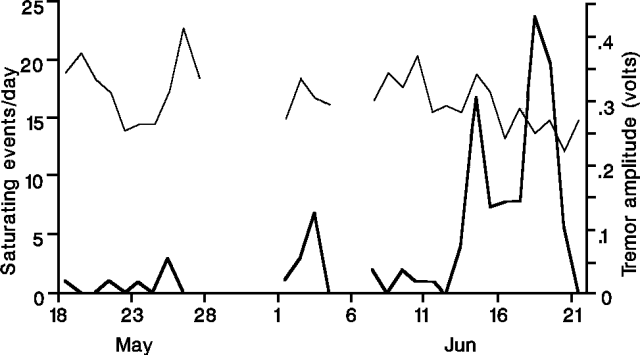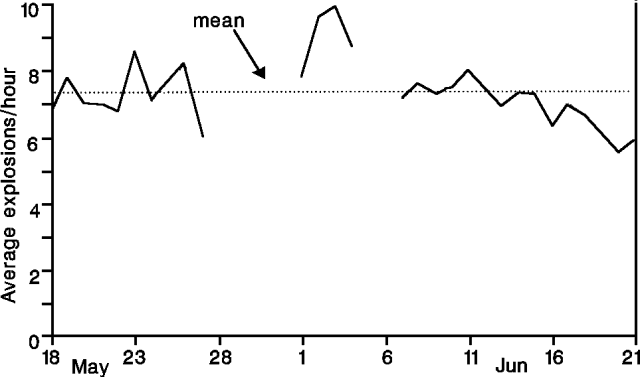Report on Stromboli (Italy) — June 1991
Bulletin of the Global Volcanism Network, vol. 16, no. 6 (June 1991)
Managing Editor: Lindsay McClelland.
Stromboli (Italy) Explosions eject glowing fragments and gas columns
Please cite this report as:
Global Volcanism Program, 1991. Report on Stromboli (Italy) (McClelland, L., ed.). Bulletin of the Global Volcanism Network, 16:6. Smithsonian Institution. https://doi.org/10.5479/si.GVP.BGVN199106-211040
Stromboli
Italy
38.789°N, 15.213°E; summit elev. 924 m
All times are local (unless otherwise noted)
The number of recorded explosion shocks remained elevated through late June (figure 15), with mean rates relatively stable near the long-term "normal value" of 6/hour. Average tremor amplitude declined slightly at the beginning of June while the number of saturating earthquakes rose sharply (figure 16). Volcano guides reported that the activity was concentrated at Crater 3, where explosions ejected glowing fragments and white gas columns that rose 100-200 m in late June. Explosions were rare from other craters, but tephra built small cones in Crater 2. White gas emission was continuous.
 |
Figure 16. Average number of seismometer-saturating events (lower curve) and average tremor amplitude (upper curve) at Stromboli, 18 May-21 June 1991. Courtesy of M. Riuscetti. |
Geological Summary. Spectacular incandescent nighttime explosions at Stromboli have long attracted visitors to the "Lighthouse of the Mediterranean" in the NE Aeolian Islands. This volcano has lent its name to the frequent mild explosive activity that has characterized its eruptions throughout much of historical time. The small island is the emergent summit of a volcano that grew in two main eruptive cycles, the last of which formed the western portion of the island. The Neostromboli eruptive period took place between about 13,000 and 5,000 years ago. The active summit vents are located at the head of the Sciara del Fuoco, a prominent scarp that formed about 5,000 years ago due to a series of slope failures which extends to below sea level. The modern volcano has been constructed within this scarp, which funnels pyroclastic ejecta and lava flows to the NW. Essentially continuous mild Strombolian explosions, sometimes accompanied by lava flows, have been recorded for more than a millennium.
Information Contacts: M. Riuscetti, Univ di Udine.


